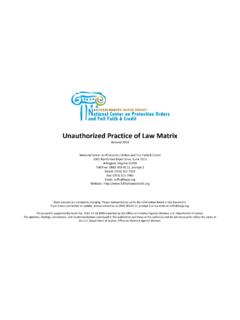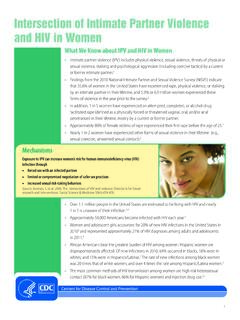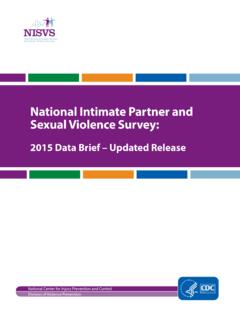Transcription of Screening, Assessment, and Intervention Model for Intimate ...
1 Screening, Assessment, and Intervention Model for Intimate partner violence Perpetration and Co-Occurring Combat-Related Conditions Glenna Tinney, MSW, ACSW, DCSW, Captain, United States Navy (Ret.) April Gerlock, PhD, ARNP, PMHNP-BC, PMHCNS-BC December 2017 The Battered Women s Justice Project 1801 Nicollet Ave South, Suite 102, Minneapolis MN 55403 800-903-0111, prompt 1 1 About the Authors Glenna Tinney, MSW, ACSW, DCSW, Captain, Navy (Ret.) is the former coordinator of the Military & Veterans Advocacy Program for the Battered Women s Justice Project.
2 She is a retired Navy Captain and was one of the original 12 Navy social workers recruited for active duty. She served for 24 years working with military families and managing worldwide family violence and sexual assault programs. She also served as the Deputy Executive Director for the Defense Task Force on Domestic violence and later worked on implementation of the Task Force recommendations on policies, procedures, and practices. In recognition of her work in the field of domestic violence , Ms. Tinney was selected by the White House as a Woman Veteran Champion of Change in March, 2013.
3 April A. Gerlock, , ARNP, PMHNP-BC, PMHCNS-BC, is a board certified adult mental health/psychiatric advanced registered nurse practitioner and research scientist. She has published a range of articles pertaining to posttraumatic stress disorder (PTSD), anger management, and Intimate partner violence . She has provided direct patient care to Veterans with PTSD and worked with both victims and perpetrators of Intimate partner violence within the VA for over 30 years. Dr. Gerlock is currently a research associate at VA Puget Sound Healthcare System (Seattle) and associate investigator with a TriService Nursing Research Program looking at reintegration in military couples after deployment.
4 In addition, she is a clinical professor with Psychosocial and Community Health Nursing at the University of Washington, School of Nursing in Seattle, WA. This document was supported by Grant No. 2011-TA-AX-K110 and 2015-WT-AX-K058 awarded by the Office on violence Against Women, Department of Justice. The opinions, findings, conclusions, and recommendations expressed in this document are those of the authors and do not necessarily reflect the views of the Department of Justice, Office on violence Against Women.
5 2 Screening, Assessment, and Intervention Model for Intimate partner violence (IPV) Perpetration and Co-Occurring Combat-Related Conditions Contents About the Authors .. 1 EXECUTIVE SUMMARY .. 3 Model FOR UNDERSTANDING Intimate partner violence PERPETRATION AND COMBAT-RELATED CO-OCCURRING CONDITIONS .. 6 THE INTERSECTION OF Intimate partner violence AND CO-OCCURRING COMBAT-RELATED CONDITIONS .. 15 A COMMUNITY-WIDE APPROACH TO SCREENING AND ASSESSMENT OF IPV PERPETRATION AND CO-OCCURRING CONDITIONS .. 28 Intervention .
6 47 CONCLUSION AND RECOMMENDATIONS .. 54 References .. 57 Appendix A: CIVILIAN-MILITARY-VETERAN COORDINATED COMMUNITY 70 Appendix B: MILITARY SERVICE SCREENING TOOL .. 73 Appendix C: Intimate partner violence ASSESSMENT TOOL .. 74 Appendix D: IPV PERPETRATION SCREENING TOOL .. 89 Appendix E: ABUSIVE BEHAVIOR INVENTORY (ABI OFFENDER FORM) .. 90 Appendix F: ABUSIVE BEHAVIOR INVENTORY (ABI partner FORM) .. 92 Appendix G: DANGEROUSNESS/RISK ASSESSMENT PROTOCOL PERPETRATOR .. 94 Appendix H: DANGEROUSNESS/RISK ASSESSMENT PROTOCOL ADULT VICTIM.
7 98 Appendix I: PTSD SCREENING TOOL .. 102 Appendix J: TBI SCREENING TOOL .. 103 Appendix K: ALCOHOL ABUSE SCREENING TOOL .. 105 Appendix L: DRUG ABUSE SCREENING TOOL .. 107 Appendix M: DEPRESSION SCREENING TOOL .. 108 3 EXECUTIVE SUMMARY The United States was at war in Iraq and Afghanistan for over a decade. Over million people served in one or both of these war zones, including an unprecedented number of National Guard and Reserve personnel. Many experienced multiple deployments, extended tours, and decreased breaks from combat.
8 The veterans of these deployments return to their spouses, children, families, and communities with visible and invisible injuries, such as combat-related post-traumatic stress disorder (PTSD) and traumatic brain injury (TBI). A small but growing number are becoming involved with the criminal justice system for a range of crimes, including Intimate partner violence (IPV). In communities across the country, medical facilities, social services, criminal justice systems, and courts are grappling with how to effectively serve this population of returning service members and their families.
9 The variety of Intervention points by which IPV victims and offenders engage with these agencies requires a broad and coordinated approach to screening, assessment, and Intervention that results in early identification of co-occurring conditions related to combat experience, so that subsequent interventions are appropriate, just, and effective. Combat experience certainly represents a source of significant traumatic stress and injury for individuals. However, it s important to note that the general population of IPV perpetrators who have never been in the military often have significant trauma histories and also exhibit co-occurring conditions such as PTSD, TBI, substance abuse, depression, and other mental health conditions.
10 Comparing the general population of IPV perpetrators without a military background and military veterans, the rate of IPV perpetration is higher among military veterans, but the dynamics and risk factors are more similar than different (Taft, Watkins, Stafford, Street, & Monson, 2011). This guide presents a Model for understanding IPV and its relationship to co-occurring combat-related conditions and recommends a community-wide approach to screening, assessment, and Intervention for IPV perpetration and co-occurring conditions.














